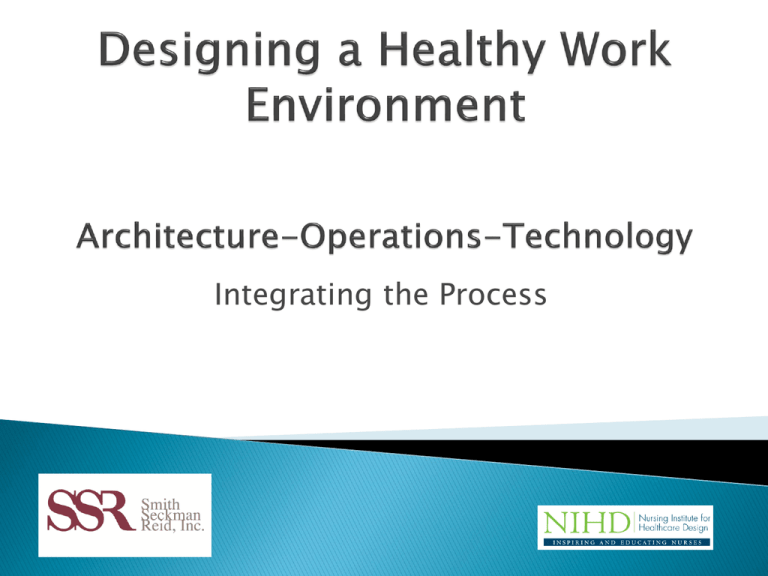Designing a Healthy Work Environment
advertisement

Integrating the Process Learning Objectives • Discover the role of the nurse in healthcare design and determine how nurses can be leaders. • Learn about evidence based design and list areas of design that have been proven to improve patient outcomes. • Learn current design and technology trends and relate those scenarios to their current work environment. • Identify nurse leadership initiatives to align the architecture and technology to support processes and work flow. Vanderbilt Nursing School 1984 1984 • • • • • Open Wards Semi Private Rooms Centralized Nursing 8 hours shifts Rolling Medicine Carts Today • Private Rooms • Decentralized Nursing • 12 hours shifts • Bar Code Medication • Patient Entertainment • Family Area Support and optimize the delivery of care models through architecture and technology Nurses have unique perspectives - Patient Safety - Family/Care giver needs - Physician Interactions - Infection Control - Working with Teams - Work flow and processes - Medication Safety - HIPAA Compliance - Communication - Organizational Culture - Organizational Initiatives - Care model/Patient care philosophy - Critical thinking skills - Outcomes oriented Interdisciplinary leadership Communication & relationship building Knowledge of the healthcare environment Business skills Professionalism Transformational leadership Stichler, JF (2007). Nurse Executive Leadership Competencies for Health Facility Design. JONA, 37(3), 109-112. Nurse Executive - Validating that the design supports the strategic vision, mission, values and culture of the organization - Stay involved Chief Nursing Officer - Ensuring that the design supports the professional practice model - Insure project continuity Director - Articulating how the design will affect costs, market share, satisfaction levels - Design principles metrics - Change management - Policies and procedures - Training Manager - Determining how the design affects staffing and patient flow - Giving staff time to participate - Create enthusiasm - Team Builder - Staffing Staff Nurse • Giving input to the architect team • Soliciting creative ideas • “Being present” • Team Supporter Nurse Project Manager • Coordinating the interdisciplinary process of design, giving a voice to all providers and patients Nurse Project Director Nurse Consultant • Managing millions or billions of dollars; keeping the project on time and within budget • Big picture/managing details • Internal to the organization or external in the architects office • Integrating the voice of nursing patient care and design • Who’s on the project team? Nurse Architect/Designer • Interfacing the design world with health care Nurse Researcher Nurse Technology Expert on work flow analysis Evidence based design is the intentional attempt to base design and construction decisions on “evidence” or “research” to improve outcomes for patients and staff. Schiphol Airport in Amsterdam Alzheimer Bus Stop The Benrath Senior Center - Düsseldorf, Germany First Evidence based Design Practitioner…. It may seem a strange principle to enunciate as the very first requirement in a Hospital that it should do the sick no harm. Florence Nightingale, 1859 Group of researchers from Texas A&M and GeorgiaTech combed through several thousand scientific articles. More than 600 research studies were found that establish a link between hospital design and improved outcomes for patients and staff. The studies were assessed on their rigor, quality of research design, sample sizes and degree of control. Patient confidentiality Noise Nature Daylight Positive distraction Social support Improved communication Medication errors Patient falls Infection control Ergonomic design Improved layout for reduced steps Consistency in design Healthcare Work Environment (Architectural/Engineering Perspective) Square Footage Requirements Building Codes and Regulations Space Planning Adjacencies Infrastructure Used by permission: Roger K. Lewis, FAIA, Architect & Planner Columnist, "Shaping the City," The Washington Post, Professor Emeritus, University of Maryland School of Architecture, Planning and Preservation Healthcare Setting Work Processes Workforce Demographics Culture and Geographic Location Information Technology You have to understand how a nurse works in a room in order to design it well Design Process Programming Schematic Design Design Development Contract Documents Construction Nursing Process Assessment Planning Intervention Evaluation Operational Model Care Delivery Philosophy Patient Population Specialty, Geriatrics, etc. Teaching vs NonTeaching Staffing ◦ Unit Secretary ◦ Team ◦ Physician Specialty HKS Architects Processes Supplies Medications Other Services Communication ◦ Workflow & Devices Documentation • Charting Alcoves • Computerized Charting • Meaningful Use • Nurse Servers • Bar-coding • RFID • OR Integration • Nurse Call • DAS • Telemetry • Network Hardware • Physiomonitoring • Security • Emergency Power Widely accepted as most beneficial. Implemented in almost all hospitals. Semi-private rooms generally occur only for: • Elderly patients who feel less confused with roommate. • Veterans who appreciate camaraderie of roommate. • Behavioral/Psychiatric settings • Small hospitals with too few resources. Single-Handed Rooms Pros: • • • Concept is accepted by many organizations. Standardization of all patients approached from same side is convenient and helps in responding to codes in room. Some hospitals incorporated angled corner walls to increase view from hallway. Single-handed rooms Cons: • • • Mirror-imaged rooms • Limited evidence of being safer – difficult to judge because every patient is different. Challenge to observe 2 patients at once from communication station outside rooms. Extra cost for not having back to back toilets (no hard numbers for difference). Pushback from nurses that they can’t adapt to mirror-imaged rooms. • • • Very convenient and saves time. TJC had issue with contamination from patient to patient – everything in room must be taken out when terminally cleaned. Now TJC accepts if minimum number of towels, linens, and supplies are put in cabinet. Need to make sure it is stocked appropriately and without unnecessary materials. Issues: • • • • Who stocks cabinet. Building codes can require the door in the corridor to have a closer, which makes server hard to keep open. Location can be inconvenient and hard to access from corridor and inside patient room. Need to displace personal effects to use bedside table for treatment. • • • • Reduces medication errors by ensuring correct medicine and dosage. Better than barcode medication administration because it is not interrupted by leaving to get medicine once scanned. Provides charge, capture, and inventory management. Operational issue: who stocks machine and how often. • • • • • Infrastructure of steel supports above ceiling being built in. More institutions want lifts in every room. Now only a percentage of rooms get lifts – typically in bariatric rooms. H-type gantry lift (moves in 4 directions) is preferred over the single rail lift, which has less flexibility. Some hospitals have lifts into bathrooms. Some hospitals utilize lift teams. Issues: • Because lifts are not in every room, nurses often don’t know how to use them. • Need education included in lift purchase. • Many lifts don’t have the necessary lift ability of 1000 pounds. Need more bariatric rooms to allow for increase in heavier patients. Issue of hygiene – make bariatric rooms with wet rooms with drains, hoses, and a hazmat containment pool. Problem with bathroom – need greater distance from wall for bariatric patients, but that exceeds the code for ADA. One console controls TV, lighting, draperies, music, and call system for nurse. Wireless keyboards for internet, communication, controls, and meal selection. Equipment: Keeps track of all equipment in hospital – helps locate and maintain inventory. Patients: Especially helpful in ER – reduces need for security and helps monitor vulnerable and dangerous patients. Staff: Very beneficial for ER and Specialty Services staff. Mostly used with Nurse Calls. Robots • Take dietary orders with filter for patient’s specific dietary needs and deliver meal trays. • Remote doctor robot has doctor’s face on screen and 2-way communication from remote location. Allows for clinicians to be involved without having to be present. Simplifies the many components of the operating room into one easy-to-use interface. Helps nurses and surgeons make decisions with centralized control of medical devices and information. Attracts better surgeons and more patients, improves patient outcome and experience, and increases efficiency. Helps ensure compliance and increases frequency of staff washing hands Improves patient safety by reducing spread of infections Technology ahead of practice transformation Smart Beds • • • Alerts staff to changes in patient’s status and movement. Can help reduce emergency reaction time. Some issue with data overload due to info coming from Smart Beds and monitors. Integration • • • • • • • • • Wireless Phones IV Pumps Telemetry Systems Admitting Systems Bed Exit Systems Smoke Detectors Staff Location, Infant Security & Asset Tracking Ventilators, Pulse Ox, AB Monitors, etc Communications Planning and Documentation Design Considerations • • • Philosophy Budget Devices Flexibility HKS Architects HKS Architects Improves staff to staff communication, patient to nurse communication, efficiency, and patient satisfaction. Reduces reaction time and overall noise by eliminating paging. Can also act as a recording device, nurse call system, and a device alarm. Healthcare applications specifically designed for iPhone being adopted and more being developed. Improves workflow process, reaction time, and efficiency. Technology is widely accepted and easy to use. Physicians Rounds – Physicians use their iPads for EHR, POE, Personalized Team Census (signout), ETicket (billing), web-based paging, and their hospital emergency department (ED) dashboard. Education, distraction and preparation - Child life specialists use it to help patients manage stress during their stay. They use the iPad to show patients how physicians prepare for surgery; to play games with patients; and to educate them about their procedures or conditions. X-ray images, EKG results and other patient monitoring programs - Used in inpatient and out patient settings by home health, hospice care workers, nurses, dietitians and pharmacists. Staff documentation – Entering the patients information on a screen that doesn’t require turning your back to the patient. Speech therapy – Speech therapist uses iPad/iPhone app Proloquo2Go with stroke victims and autistic patients to enable patients to speak through the devices to their care team. Mobile Health • • • • • • Wireless DAS Smart Phones Tablets Emergency Power Telehealth Challenges Foreseen “The first rule of any technology used in a business is that automation applied to an efficient operation will magnify the efficiency. The second is that automation applied to an inefficient operation will magnify the inefficiency.” Bill Gates Increases efficiency Reduces administrative work Improves safety for patients and staff Improves workflow processes Better reaction times Improves patient experience Convenience Many are easy to use Improves communication and decision making Difficult to change culture of routine and “old ways,” especially among older staff Learning curve for some technology Requires training Data overload Until staff are sure of devices, need backup – dual info If not widely integrated, less likely to use or remember how to use Not all advances have proven benefits Evidence Based Design is improving the healthcare environment A Nursing Advocate needs to be at the table Technology is ahead of practice transformation Designing for technology must become evidence based to improve healthcare delivery and determine best practices Aligning: Corporate Vision Clinical Vision Architecture Vision IT Vision NIHD Founding Board of Directors Nurses Planning Session Nursing Institute for Healthcare Design ( NIHD) ◦ www.nursingihd.com Center for Health Design (CHD) ◦ www.healthdesign.org Joint Commission Resources ◦ www.jcrinc.com Institute for Healthcare Improvement ◦ www.ihi.org Agency for Healthcare Research and Quality (AHRQ) ◦ www.ahrq.org Robert Wood Johnson Foundation (RWJF) ◦ www.rwjf.org • Health Environments Research & Design Journal (HERD) • Facility Care • Healthcare Design • Journal of Nursing Administration- Healthcare Design Feature • Critical Care Nursing Quarterly – Design Issue • Healthcare Design’13 ◦ November 16-19, 2013 ◦ Orlando, Florida ◦ Nursing Institute for Healthcare Design • ASHE PDC 2014 • March 16-19, 2014 • Orlando, Florida Debbie Gregory RN, BSN Senior Clinical Consultant SSR Technology Group Smith, Seckman, Reid, Inc. 615-714-6794 dgregory@ssr-inc.com The Nursing Institute for Healthcare Design www.nursingihd.com








